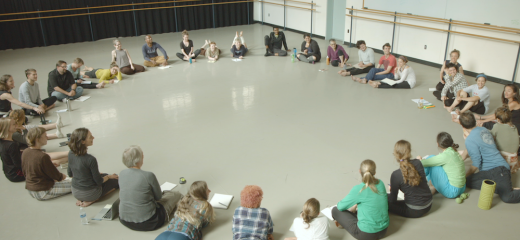
A Love Letter from the Field
by Kat Sullivan
Almost every year, the Movement Intensive in Compositional Improvisation at Franklin & Marshall College has begun on a blistering Sunday evening in the third week of June with a check-in around the circle—a space to share who you are, where you’re from, and what brought you there. This year, as I wait for an opportunity to pipe up, sitting with the anticipatory weight of diving into icy water, I feel the tethers of sharings past wafting through my brain. At the MICI I attended right after graduating from F&M in 2014, I was there to wade through the not-knowing what life after school holds. It felt clichéd, even at the time. The next year I was there to “terrify myself,” as I so dramatically put it, after feeling so far out of my comfort zone. This year, I nod along when another participant shares that they are here simply because “it’s time,” just as one returns home after a spell or a season unfolds into the next, because it was time to make space for the work of composing improvisationally with an ensemble. I am not able at this time to find this practice elsewhere in my life. I need it too much to go without.
When recollecting MICIs previous during the week, I shared that I had left my first ever in 2012 feeling petrified, humiliated, and so in love with the work.

“Intention is legible” – Pamela Vail*, movement improviser with The Architects** and a facilitator at MICI
It is a complicated task to use language to describe the art that happens here. MICI draws a multitude of movers with different backgrounds (some dance, some theater, some between or neither) and makers (poets, quilters, and more). The Architects serve as guides into the realms of movement and vocalizing, and Jason Palamara provides complex and sensitive musical accompaniment. He and Chris Brooks, who wields his violin as an improvisational instrument this year, often dip in and out of the movement. Together, we are a diverse whole.
To move and create sound with an ensemble, to improvise with the collective intention of composing, is to place oneself in the midst of opposing forces, holding both with equality. There is no practice to perform; the practice is the thing. Improvising is choosing to pay attention to the outer and to the inner; honoring your own material while remaining sensitive to what is required of the whole. Composing is to shape it. One of Pam’s soft-worn and beloved reminders each year: “Don’t assume you know what you’re doing, and don’t assume you don’t know what you’re doing.” It’s the work of being in the thick of it, of being deep in the trenches, while simultaneously stepping out to observe: what are your choices? what are your assumptions? It seems so simple, yet it holds so much complexity. It’s letting things unfold and having agency.
It’s making while being made.
And the question begs, how does one begin this work? To put it simply/complexly, just show up. To begin is to drop in, to know what you’re doing, and to drop outside enough to witness it. You may reach a point where you feel so tangled up in a knot in your head trying to decipher what means what and when to move. Quoting Adrienne Maree Brown’s Emergent Strategy, Pam guides us, “Move at the speed of trust.” Trust that you know what to do even if you don’t know what to do. There are a thousand ways to know something. Go.

“Attention emerges from the sensing body; it is the body” – Lisa Gonzales, movement improviser with The Architects and a facilitator at MICI
Attending to the present is as religious a ritual as church and as elemental a knowing as biology. The medium of the moment is movement and sound of the body, and thus a different kind of sensing and knowing emerges than one might utilize in daily life, or even in other performative forms. This is not a switch, not a one-time awakening; paying attention is the practice of again and again and again and again and again. Just as one must come up for air in order to swim deeper; just as one stitch after another must be sewn though the fabric in order to hold it together. This is dynamic, not static, and our bodies are doing this all the time. As Lisa shared with us during this year’s intensive, presence to becoming is a necessary force in our biology. Our very cells are constantly folding into something new; our brains need chaos in order to identify alignment.
Forms are emerging, composing is already happening.
Every so often in the work, if you are deeply sensing and attending, you will surprise yourself; the form will surprise itself. Like unwrapping a gift, if you are able to stay in it and notice each new thing as it is revealed without trying to name it too soon, you will arrive somewhere you didn’t realize you were heading. This year, as an ensemble, we practiced an improvisational score where everyone walks around the room in a circle and at one moment, someone enters the middle and assumes a stationary shape. Two more enter and do the same. All feel how the thing shifts, coalesces, and disintegrates as the three blend back into the exterior circle. Repeat. Though not part of the score, after a few rounds, a fourth person entered to join the three; that person remained while the others returned to the circle and two more joined them; a fourth person joined those three; and again and again. Each section no longer had a clear end and they dovetailed each into another; what we were doing became entirely new.
Sometimes this shift is sudden. Sometimes it is drawn out and subtle. It can be so hard to let the plant grow and trust the roots are taking hold.

“You can make a connection between any two things; if you go far enough, even parallel lines connect” – Katherine Ferrier, movement improviser with The Architects and a facilitator at MICI
What does it mean to say a radical yes to what’s already happening? Is that commitment? If so, what are you committing to: what that moment calls for or its infinite ability to transform? Midway through the week, Katherine, a maker in many media, shares that the Latin etymology for “radical” is “to root.” Here is yet another paradox of composing improvisationally: in order to be wildly open, one must ground deeper. Possibilities emerge when we become aware of what already is.
Often, I’ve found, this is where the transformation occurs, though I hesitate to imply any sort of consistent, repeated experience; the piece is, after all, made entirely new in the moment. During one afternoon exploration, I was deep in the thick of a thing. It was rigorous to stick with it without being able to identify it; I was working to lean into the trust of knowing by sensing, to not abandon the material for something I could better understand. I was so deeply enmeshed that initially, when another participant moved into a duet with me, I resisted. I needed to know where I was before I could possibly see how it fit with others. However, I felt the “yes” in the material, in the moment, and in the work, so I opened my attention/intention to moving together. Their presence and what they were presenting helped me identify where I was; I saw myself in relationship to them. I was simultaneously anchored and coming up to the surface.
There’s always material present. Everything is a metaphor for everything else. Trust is radical.

“So much of our understanding of space is relational” – Kathy Couch, lighting and space designer, collaborator with The Architects, and a facilitator at MICI
When a spider spins a web, it’s mostly space. The web comprises spindling threads containing the spider’s own cells; it is both the spider and of the spider. The space between two threads is as much part of the whole as the threads themselves. It is what allows us to identify the threads.
Object Day, when Kathy designs and leads us into a playfully curated space of items to move with and relate to, has historically been a frustrating one for me. The differences between me and my object—a set of decorative, thin wooden stakes in a plastic bag (in prior years a fan, a broom, a roll of tin foil)—feel too vast to identify what the object is in this moment and where I am in relationship to it. In an effort to honor what is true in the now, we try to approach the items with the same sense of receptivity—to allow what they are now to be revealed, not labeled nor assumed. This requires both rigor and softness.
As I sit typing this, a spider crawls across my computer, no web in sight.
I believe Kathy was quoting someone when she said, “Attention is the rarest and purest form of generosity.” Indeed, it is humbling to dance with an object in this way. It is a continual suspension of logic, of any understanding you may have brought in with you from “out in the world,” in order to find the place of “now this is a thing that I drop”; “now this is a thing that lets me push it along the floor”; “now this is a thing that moves ahead of me, a proboscis, that tests the waters.” Every time, the fear of What if I enter and don’t know what to do or What if I fall back on my literal understanding of this is thrown into sharp relief. Hand-in-hand with suspending logic must be trust, trust that softens you just enough to break your sense of logic a bit.

“Ensemble improvisation is an ideal of collective action” – Jennifer Kayle, movement improviser with The Architects and a facilitator at MICI
Another beloved Katherine Ferrier-ism: “This work is a lifelong practice and it’s a practice for life.” The work is reflective and revealing on a personal level; often, the assumptions and shticks you bring into the work are parallel to the ones you bring into the world. It has taken me years, for example, to learn how to be in a duet with someone without just mimicking whatever they’re doing. Complexity, multiplicity, and trust. It’s also a map for making things together without hierarchy, without attachment. In other words, exactly what we need right now.
Jennifer is researching this and more with collaborator and colleague Ali Hasan at the University of Iowa. They presented material on intention, autonomy/agency, and the ensemble during MICI; I couldn’t possibly do it justice and highly recommend reaching out to her if you’d like to know more. Strangely, hearing their research felt familiar to my body. Yes, of course, this is a profound idea but one I’ve always known. Welcome, thinking mind.
The rigor of this mode of sensing, of feeling moment to moment, is intense and not to be underestimated; it has the power to crack you right open. The potential of a group of people intending to self-organize spontaneously in this way has the power to change the world.
On the final day of the intensive, during the Last Dance, I was attending to my own solo material, warming up the awareness within and of my body. As this attention expanded, I felt myself becoming aware of two dancers on either side of me; I was moving between them, tethering them, and this was what the piece we were collectively creating needed me to do. I moved in this way, keeping us all together with my awareness while continuing to attend to my own material. As the piece formed, the two dancers shifted farther and farther away from one another into the room; I continued as the force between them, sewing together the gap with my movement. Suddenly, a new knowing emerged; the two dancers I was attending to were no longer aware of one another directly. They had both entered new chapters of the piece with other groups. I was attempting to keep two things together that had since transformed into something new, no longer intending to move together as a “we”. On the precipice of re-entry into the real world, in the most exquisite way, this broke my heart.
*Pamela Vail was the author’s professor in college.
** Note: The Architects are four women who, alongside various collaborators, teach, practice, and perform compositional improvisation as an ensemble. I have attempted to cite sources when directly quoting someone, but please know that many of the concepts in this piece were taught to me during MICI. I am incredibly grateful to each of them for all they have passed on.
All images courtesy of Tori Lawrence.
Movement Intensive in Compositional Improvisation with The Architects, Franklin & Marshall College, June 17-24.
By Kat J. Sullivan
July 9, 2018

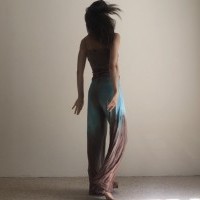
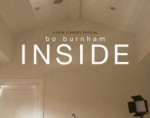
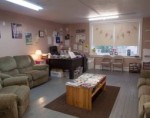
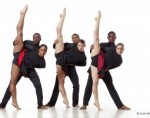

.png)


